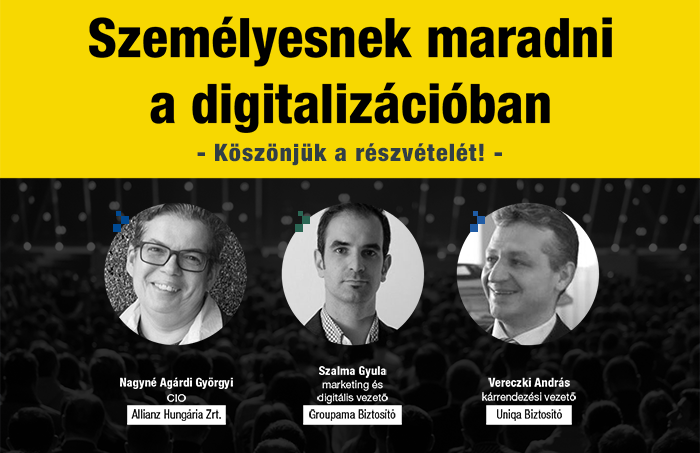
Remaining Personal During Digitalisation
Ez a bejegyzés még ezeken a nyelveken is olvasható: magyar
What experiences have business professional gathered when they found themselves in a customer role? Is customer service truly the in center of the insurance practice? Are the boundaires of digital and personal meetings really clear? What is the scope of competence of artifical intelligence? Is there such a thing as insurance without human contact?
On May 19th we have held a roundtable with more than 100 people attending in the audience, titled "Remaining Personal During Digitalisation".
The roundtable discussion was held between Györgyi Nagyné Agárdi CIO of Allianz Hungaria, Gyula Szalma head of marketing and digital of Groupama Assurance in Hungary and András Vereczki head of claims at Uniqa Insurance in Hungary.
Experiences about the smoothness of digital service gathered by the participants when they themselves had been in a customer role was varied but mostly positive. They agreed that in case an organisation actually takes stock in their customers, if the enterprise is market-oriented, then sloppiness will not be tolerated and close tracking will be carried out in the digital sphere. Mr. Vereczki recalled a recent case when he had dropped out of filling a digital form, which was immediately noticed by the company and shortly afterwards he received a tracking phone call, offering assistance.
An intriguing debate emerged about the question whether such active customer service is widespread in the insurance industry. Mr. Szalma used a self-critical tone as he voiced that insurers may not feel compelled to communicate in a truly customer-friendly fashion. Ms. Agárdi on the other hand believed that customer-centricity is already in the spotlight of attention in the industry and there is a constant thrive to gain customer satisfaction.
There was agreement around the issue of present day customer contact being much more complex than lending itself to a simple distinction between what is 'personal' and what is 'digital'. Let us consider that advisors themselves use technology and support customers in applying digital tools as well. It is therefore essential for them to use the same applications, for the internal and customer facing infrastructures to be unified, as was emphasised by Ms. Agárdi. Neither is telephony the same decade old technology any more, voice contact is embedded into a digitial environment. Well known technologies such as speaker phones, group calls, video conferences all represent an extension of the old phone as we once knew it. This tool will continue to stay with us in its evolving shapes, Mr. Vereczki believed.
New boundaries may lie in the application of artifical intelligence. Certain ways of robotisation have been in use from quite some time now within the orgnisations as software 'bots' can substitute for humans in standard processes powered by business applications. Risk analysis and claims validations also provide ground for AI based data analytics. However, this is not the same as providing customer service via artifical intelligence. Human participation seems to be an inevitable part of such activities, and not merely for technological reasons. A truly personal attention, a personal tone, shared activities and joint problem solving contains added value which cannot be gained oherwise - concluded the roundtable.
As a closing act of the program, DBX's expert Péter Fülöp Péter showcased an model process in digital communication in which the customer's behavior influences the workings of the system and thus controls the process. A business proposal was delievery by Hammy through e-mail which was closely tracked by the service provider and it noted if the customer had actually opened the message. At that point Hammy made sure the advisor was included in further customer activities. The advisor could answer all customer questions and close the new sale successfully.
A bejegyzés teljes szövege a medium.com-on olvasható